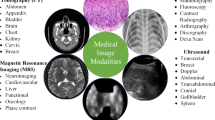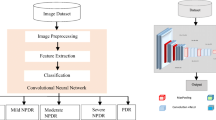Abstract
This paper proposes a deep image analysis–based model for glaucoma diagnosis that uses several features to detect the formation of glaucoma in retinal fundus. These features are combined with most extracted parameters like inferior, superior, nasal, and temporal region area, and cup-to-disc ratio that overall forms a deep image analysis. This proposed model is exercised to investigate the various aspects related to the prediction of glaucoma in retinal fundus images that help the ophthalmologist in making better decisions for the human eye. The proposed model is presented with the combination of four machine learning algorithms that provide the classification accuracy of 98.60% while other existing models like support vector machine (SVM), K-nearest neighbors (KNN), and Naïve Bayes provide individually with accuracies of 97.61%, 90.47%, and 95.23% respectively. These results clearly demonstrate that this proposed model offers the best methodology to an early diagnosis of glaucoma in retinal fundus.
Graphical abstract


















Similar content being viewed by others
References
Siamak YG, Michael H, Madhusudhanan B, Tzyy-Ping J, Robert WN, Felipe MA, Linda ZM, Jeffrey LM, Christopher GA, Christopher B (2013) Glaucoma progression detection using structural retinal nerve fiber layer measurements and functional visual field points. IEEE Trans Biomed Eng 61(4):1143–1154
Cheng J, Liu J, Xu Y, Yin F, Tan NM, Wong WKD, Lee BH, Cheng X, Gao X, Zhang Z, Wong TY (2017) Methods and systems for automatic location of optic structures in an image of an eye, and for automatic retina cup-to-disc ratio computation. US Patent 9:684,959
Martins J, Cardoso JS, Soares F (2020) Offline computer-aided diagnosis for glaucoma detection using fundus images targeted at mobile devices. Comput Methods Prog Biomed 192:105341
Kourkoutas D, Karanasiou IS, Tsekouras GJ, Moshos M, Iliakis E, Georgopoulos G (2012) Glaucoma risk assessment using a non-linear multivariable regression method. Computer Methods Programs Biomed 108(3):31149–31159
Singh, L. K., & Garg, H. (2019). Detection of glaucoma in retinal fundus images using fast fuzzy C means clustering approach. In 2019 International Conference on Computing, Communication, and Intelligent Systems (ICCCIS) (pp. 397-403). IEEE
Ortíz, D., Cubides, M., Suárez, A., Zequera, M., Quiroga, J., Gómez, J. and Arroyo, N., (2010). Support system for the preventive diagnosis of hypertensive retinopathy. In: Annual International Conference of the IEEE Engineering in Medicine and Biology (pp. 5649-5652). IEEE
Atto AM, Pastor D, Mercier G (2008) Detection threshold for non-parametric estimation. SIViP 2(3):207–223
Deepti Y., Partha MS., Malay K.D., (2014). Classification of glaucoma based on texture features using neural networks. In 7th International Conference on Contemporary Computing (IC3) (pp. 109-112). IEEE
Saleh MD, Eswaran C, Mueen A (2011) An automated blood vessel segmentation algorithm using histogram equalization and automatic threshold selection. J Digit Imaging 24(4):564–572
Roodhooft J (2002) Leading causes of blindness worldwide. Bull Society BelgeOphtalmol 283:19–25
Haleem MS, Han L, Van Hemert J, Li B (2013) Automatic extraction of retinal features from colour retinal images for glaucoma diagnosis: a review. Comput Med Imaging Graph 37(7–8):581–596
Abdel-Hamid L (2020) Glaucoma detection from retinal images using statistical and textural wavelet features. J Digit Imaging 33(1):151–158
Tuck MW, Crick RP (1992) Screening for glaucoma: age and sex of referrals and confirmed cases in England and Wales. Ophthalmic Physiol Opt 12(4):400–404
George R, Ve Ramesh S (2010) Glaucoma in India: estimated burden of disease. J Glaucoma 19(6):391–397
Quigley HA, Broman AT (2006) The number of people with glaucoma worldwide in 2010 and 2020. Br .J .Ophthalmol 90(3):262–267
Vajaranant TS, Wu S, Torres M, Varma R (2012) A 40-year forecast of the demographic shift in primary open-angle glaucoma in the United States. Invest Ophthalmol Vis Sci 53(5):2464–2466
Acharya UR, Ng EYK, Eugene LWJ, Noronha KP, Min LC, Nayak KP, Bhandary SV (2015) Decision support system for the glaucoma using Gabor transformation. Biomedical Signal Processing and Control 15:18–26
Gajbhiye GO, Kamthane AN (2015) Automatic classification of glaucomatous images using wavelet and moment feature. In: annual IEEE India conference (INDICON), pp 1–5
de Sousa JA, de Paiva AC, Sousa de Almeida JD, Silva AC, Junior GB, Gattass M (2017) Texture based on geostatistic for glaucoma diagnosis from fundus eye image. Multimed Tools Appl 76(18):19,173–19,190
Soltani, A., Badaoui, A., Battikh, T. and Jabri, I., (2018). A novel system for glaucoma diagnosis using artificial neural network classification. In: 5th International Conference on Control, Decision and Information Technologies (CoDIT) (pp. 1128-1133). IEEE
Kim, P.Y. &Iftekharuddin, K.M. (2013). Novel fractal feature-based multiclass glaucoma detection and progression prediction, IEEE J. Biomed. Health. Inf. 17 (2)
Maheshwari S, Pachori RB, Kanhangad V, Bhandary SV, Acharya UR (2017) Iterative variational mode decomposition based automated detection of glaucoma using fundus images. ComputBiolChem 88:142–149
Al-Bander, B., Al-Nuaimy, W., Al-Taee, M. A., &Zheng, Y. (2017). Automated glaucoma diagnosis using a deep learning approach. In 2017 14th International Multi-Conference on Systems, Signals & Devices (SSD) (pp. 207-210). IEEE
Rajendra Acharya U, Dua S, Xian D, VinithaSree S, Chua CK (2011) Automated diagnosis of Glaucoma using texture and higher order spectra features. IEEE Trans InfTechnol Biomed 15(3):449–455
Zhou W, Yi Y, Bao J, Wang W (2019) Adaptive weighted locality-constrained sparse coding for glaucoma diagnosis. Medical & Biological Engineering & Computing 57(9):2055–2067
Guo, F., Li, W., Tang, J., Zou, B., & Fan, Z. (2020). Automated glaucoma screening method based on image segmentation and feature extraction. Medical & Biological Engineering & Computing, 1-20
Kim SJ, Cho KJ, Oh S (2017) Development of machine learning models for diagnosis of glaucoma. PLoS One 12(5):e0177726
An, G., Omodaka, K., Hashimoto, K., Tsuda, S., Shiga, Y., Takada, N.,& Nakazawa, T. (2019). Glaucoma diagnosis with machine learning based on optical coherence tomography and color fundus images. Journal of Healthcare Engineering, 2019
Lee SD, Lee JH, Choi YG, You HC, Kang JH, Jun CH (2019) Machine learning models based on the dimensionality reduction of standard automated perimetry data for glaucoma diagnosis. Artif Intell Med 94:110–116
Civit-Masot J, Domínguez-Morales MJ, Vicente-Díaz S, Civit A (2020) Dual machine-learning system to aid glaucoma diagnosis using disc and cup feature extraction. IEEE Access 8:127519–127529
David DS, Jayachandran A (2020) A new expert system based on hybrid colour and structure descriptor and machine learning algorithms for early glaucoma diagnosis. Multimed Tools Appl 79(7):5213–5224
Benzebouchi NE, Azizi N, Ashour AS, Dey N, Sherratt RS (2019) Multi-modal classifier fusion with feature cooperation for glaucoma diagnosis. Journal of Experimental & Theoretical Artificial Intelligence 31(6):841–874
Raj A, Tiwari AK, Martini MG (2019) Fundus image quality assessment: survey, challenges, and future scope. IET Image Process 13(8):1211–1224
Kanse SS, Yadav DM (2020) HG-SVNN: harmonic genetic-based support vector neural network classifier for the glaucoma detection. Journal of Mechanics in Medicine and Biology 20(01):1950065
Shehryar, T., Akram, M. U., Khalid, S., Nasreen, S., Tariq, A., Perwaiz, A., &Shaukat, A. (2020). Improved automated detection of glaucoma by correlating fundus and SD-OCT image analysis. International Journal of Imaging Systems and Technology. 1–20
Ajesh F, Ravi R (2020) Hybrid features and optimization-driven recurrent neural network for glaucoma detection. Int J Imaging Syst Technol 30:1143–1161
Ajesh, F., Ravi, R., & Rajakumar, G. (2020). Early diagnosis of glaucoma using multi-feature analysis and DBN based classification. Journal of Ambient Intelligence and Humanized Computing, 1-10
Gour, N., & Khanna, P. (2019). Automated glaucoma detection using GIST and pyramid histogram of oriented gradients (PHOG) descriptors. Pattern Recogn Lett
Raghavendra U, Fujita H, Bhandary SV, Gudigar A, Tan JH, Acharya UR (2018) Deep convolution neural network for accurate diagnosis of glaucoma using digital fundus images. Inf Sci 441:41–49
Phan S, Satoh SI, Yoda Y, Kashiwagi K, Oshika T, Japan Ocular Imaging Registry Research Group (2019) Evaluation of deep convolutional neural networks for glaucoma detection. Jpn J Ophthalmol 63(3):276–283
Khalil T, Akram MU, Khalid S, Jameel A (2017) Improved automated detection of glaucoma from fundus image using hybrid structural and textural features. IET Image Process 11(9):693–700
Salam AA, Khalil T, Akram MU, Jameel A, Basit I (2016) Automated detection of glaucoma using structural and non-structural features. Springerplus 5(1):1519
Issac A, Sarathi MP, Dutta MK (2015) An adaptive threshold based image processing technique for improved glaucoma detection and classification. Comput Methods Prog Biomed 122(2):229–244
Vijapur NA, Kunte RSR (2017) Sensitized glaucoma detection using a unique template based correlation filter and undecimated isotropic wavelet transform. Journal of Medical and Biological Engineering 37(3):365–373
Xiong, L., Li, H. and Zheng, Y., (2014). Automatic detection of glaucoma in retinal images. In 2014 9th IEEE Conference on Industrial Electronics and Applications (pp. 1016-1019). IEEE
Juneja, M., Singh, S., Agarwal, N., Bali, S., Gupta, S., Thakur, N., & Jindal, P. (2019). Automated detection of glaucoma using deep learning convolution network (G-net). Multimedia Tools and Applications, 1-23
Hagiwara Y, Koh JEW, Tan JH, Bhandary SV, Laude A, Ciaccio EJ, Tong L, Acharya UR (2018) Computer-aided diagnosis of glaucoma using fundus images: a review. Comput Methods Prog Biomed 165:1–12
Jorge, B., Barrera, D., Caro, MP, Estupinan, AM, Gonzalez-Neira, EM, Perez, N., Carlos, S., Suarez, DR and Torres, MJ, (2018). Dispatch rules in programming of elective surgical procedures: impact on occupation and opportunity indicators. Health Sciences Magazine
Chai Y, Liu H, Xu J (2020) A new convolutional neural network model for peripapillary atrophy area segmentation from retinal fundus images. Appl Soft Comput 86:105890
Noronha K, Acharya UR, Nayak KP, Kamath S, Bhandary SV (2013) Decision support system for diabetic retinopathy using discrete wavelet transform. Proceedings of the Institution of Mechanical Engineers. Part H, Journal of engineering in medicine 227(3):251–261
Singh LK, Garg H (2020) Detection of glaucoma in retinal images based on multiobjective approach. International Journal of Applied Evolutionary Computation (IJAEC) 11(2):15–27
Fink, F., Worle, K., Gruber, P., Tome, A.M., Gorriz-Saez, J.M., Puntonet, C.G. and Lang, E.W., (2008). ICA analysis of retina images for glaucoma classification. In: 30th Annual International Conference of the IEEE Engineering in Medicine and Biology Society (pp. 4664-4667). IEEE
Orujov, F., Maskeliunas, R., Damaševičius, R., & Wei, W. (2020). Fuzzy based image edge detection algorithm for blood vessel detection in retinal images. Applied Soft Computing, 106452
Zilly J, Buhmann JM, Mahapatra D (2017) Glaucoma detection using entropy sampling and ensemble learning for automatic optic cup and disc segmentation. Comput Med Imaging Graph 55:28–41
Salazar-Gonzalez A, Kaba D, Li Y, Liu X (2014) Segmentation of the blood vessels and optic disk in retinal images. IEEE Journal of Biomedical and Health Informatics 18(6):1874–1886
Yousefi S, Goldbaum MH, Balasubramanian M, Medeiros FA, Zangwill LM, Liebmann JM, Girkin CA, Weinreb RN, Bowd C (2014) Learning from data: recognizing glaucomatous defect patterns and detecting progression from visual field measurements. IEEE Trans Biomed Eng 61(7):2112–2124
Toğaçar M, Özkurt KB, Ergen B, Cömert Z (2020) BreastNet: a novel convolutional neural network model through histopathological images for the diagnosis of breast cancer. Physica A: Statistical Mechanics and its Applications 545:123592
Fathi A, Naghsh-Nilchi AR (2013) Integrating adaptive neuro-fuzzy inference system and local binary pattern operator for robust retinal blood vessels segmentation. Neural Comput & Applic 22(1):163–174
Toğaçar M, Ergen B, Cömert Z (2020) Detection of lung cancer on chest CT images using minimum redundancy maximum relevance feature selection method with convolutional neural networks. Biocybernetics and Biomedical Engineering 40(1):23–39
Author information
Authors and Affiliations
Corresponding author
Ethics declarations
Conflict of interest
The authors declare that they have no conflict of interest.
Additional information
Publisher’s note
Springer Nature remains neutral with regard to jurisdictional claims in published maps and institutional affiliations.
Rights and permissions
About this article
Cite this article
Singh, L.K., Pooja, Garg, H. et al. An enhanced deep image model for glaucoma diagnosis using feature-based detection in retinal fundus. Med Biol Eng Comput 59, 333–353 (2021). https://doi.org/10.1007/s11517-020-02307-5
Received:
Accepted:
Published:
Issue Date:
DOI: https://doi.org/10.1007/s11517-020-02307-5




